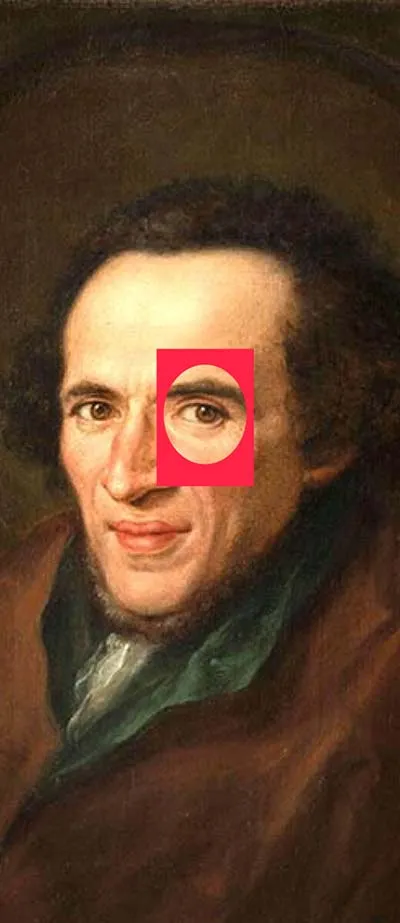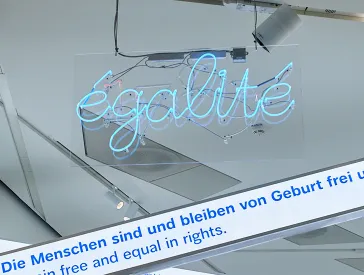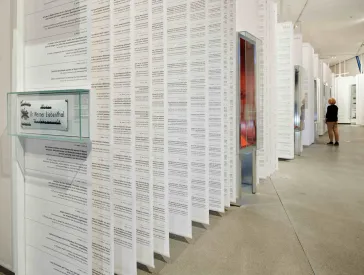Based on a True Story
An Interview With the Artist Typex on his Graphic Novel Moishe about Moses Mendelssohn
Typex is an illustrator, comic artist and painter based in Amsterdam. He has been drawing comics since his youth and gained international fame in 2013 with his graphic biography of Rembrandt. In 2018, he published Andy – A Factual Fairytale about the life of Andy Warhol. Moses Mendelssohn, the most important Jewish Enlightenment philosopher, is the next star Typex lovingly brings to life in the book Moishe. We talked to him about working as a drawing biographer—and why he prefers stories to reality.
JMB: Your graphic novel Moishe features six well-known anecdotes around the famous Jewish philosopher—and a brand-new Moses Mendelssohn. What made you participate in the Jewish Museum Berlin’s (JMB’s) “call for comics”?
Typex: Well, I had already done graphic novels on the lives of Andy Warhol and Rembrandt. To be honest, I told my publisher those would be my last biographies. But I’m always a sucker for interesting stories, and I believe that when life offers you an opportunity, you should grab it with both hands! Before I knew it, I was completely engulfed in the world of Moses Mendelssohn.
Your Moses Mendelssohn—Moishe—is very lively, and readers are immediately drawn to his character. How did you get to know him, his personality?
When I approach a project like this, I read a lot about the person, and especially I look at pictures. Of course, that was easier with someone like Rembrandt, because he made so many self-portraits. You only see Mendelssohn through the eyes of his contemporaries. But still, there are some important portraits, for example the one that the exhibition uses as a sort of centerpiece. It’s a very striking portrait and you can see so much character in it! That’s unusual for the time, and I began to catch a glimpse of Moses.
Portrait of the artist Typex; photo: Ringel Goslinga
He was such a modern man, and there was so much goodness, gentleness in him. All that seemed to contrast with his looks: his hunched back, his protruding chin, the crooked nose. He has the features of a jester, and—though I hate to admit it—he reminded me of Punch from Punch and Judy or the commedia dell’arte.
His appearance and, of course, especially being Jewish in the Prussia of that time made him vulnerable, and he must have been very strong to endure that. So, for the graphic novel, his character needed some softness—not weakness, but something or someone to make him strong, to give him balance. Then I saw a portrait of Fromet where she struck me as a really confident woman. That’s the balance Moishe needs: She fills in the blanks. They need each other and they bring out certain things in each other. So when I had Fromet, that was the moment I had Moishe pinned down, too.
Did you become friends?
Yes, it’s hard not to like him! In fact, in a way that was a problem, because I didn’t want to romanticize. It was a relief when I read that he did have a temper, because you need to have some struggle within.
Were there any surprises when you worked on Moishe?
I like to have the flexibility to add things, even when I’m already finishing a story, so I find most surprises pleasant! “What first surprised me about Moses was the contemporary feel of his ideas.” I was also amazed that even in those days, the media were already so important—although that shouldn’t be surprising, because people haven’t changed that much since then! People are nasty, and they will always find a way to spread their tales. You can see that in the story of the dispute between Mendelssohn and Lavater.
Typex: Moishe. Six Anecdotes From the Life of Moses Mendelssohn, Scratch Books, Amsterdam 2022; 88 Pages, 24,- €; ISBN 978-94-93166-59-2
From the graphic novel Moishe. Six Anecdotes From the Life of Moses Mendelssohn: Moses' dream of Lavater. Typex, Amsterdam 2022
How do you go about starting a project about a historical person?
When you do a life story from birth to death, it’s very hard to find your focus. You read everything you can about the person, and it takes a long time to know where you’re heading, because you have to find a path through all the information. The difference between my earlier projects and this one is that here I had the anecdotes the JMB gave me as a starting point. That was a very straightforward guide and it made things a lot easier.
Also, with a guideline, you are limited in the number of characters. It’s like a theater: you have a certain cast, and now you have to see how they relate to each other. And because you have one main character, every other figure serves to shape that protagonist, either through contrast, as with Fromet, or as the bad guy, like Lavater. And then there’s Abba Glosk, who is also a counterbalance to Moishe because he speaks to Moishe’s conscience. Although Abba and Moishe are in the same boat, they manage to go in different directions. All these characters bring out different aspects of Moishe’s character.
One minor character is the constantly drunk Abraham Wolff, a teacher in the Mendelssohn household. What role does he play?
I wanted Wolff to be a sort of anchor for Moishe. We all need a best friend to show us where we’re coming from, and Wolff is unflappable. Well, most of the time he is sleeping or seems to be sleeping, but he’s just a little footnote to Moishe. He doesn’t get a big part, but an essential small part.
So does Brendel or Dorothea, Mendelssohn’s eldest daughter.
Yes, I began to read about her and was astonished. She was exactly what I needed! I had put a child in the first sketched version, just a child Moses had, but it didn’t really have a character. Then I realized Brendel was not just any child, but a little proto-feminist! I was so happy with that. I based that whole chapter around her—part of it, anyway.
Obviously, a museum is obliged to remain true to historical fact in its exhibitions. An artistic approach, even one based on true stories, can be much more open. How close do you stay to the historical events around Moses Mendelssohn?
I call stories based on truth “factional stories,” and I follow one principle: never let the truth get in the way of a good story! In a story there’s something you want to convey, a thought about a character, a person, or whatever. If you need to change the order of events or even change an event a bit to make it clear what you want to say, then do! Anyway, it’s an illusion to think you’re recreating truth—that’s impossible. Especially from Moishe’s era itself, all we have are accounts by people of that time, and they are so partial in every aspect. Also, you can hear a story in a million different ways. For me, there is no objective truth. A story is always more believable than the truth.
From the graphic novel Moishe. Six Anecdotes From the Life of Moses Mendelssohn; Typex, Amsterdam 2022
Images, especially caricatures, can easily cause conflicts. How far can a comic go? And are you afraid of that your Moishe might provoke any conflict?
An image can’t be guilty of anything, it is what the viewer makes of it—unless it is made with bad intentions. As an artist, I’m very much aware of that, and I try to give everyone I draw a true appearance¬—true to the person. I don’t like the kind of visual assimilation that can result from wanting not to appear racist or whatever. We’re not all the same! Vive la difference! And in the case of Moses Mendelssohn, his extreme appearance played such a big part in his life. There are so many very different portraits of him, for example the famous picture with Lavater, where Moses is made more handsome in terms of the fashion of that era. He is a very handsome man, I think, and yet he also reminds you of a harlequin. There’s a lot of beauty, there’s kindness in him, especially in his eyes. It would be terrible to make Moishe look less like himself.
Also, comics are like a theater play: you have to emphasize looks and make things visible even to the people sitting in the last row. So my job is to make it clear that Moses’s extreme appearance is what this man has to deal with every single day. And look at the brilliant way he does it! He is funny. He’s not dragged down by his body. Take the scene where he is being treated with blatant racism by the two officers who question him when he reaches Potsdam. Those two men are really awful, but he isn’t distracted by them for a moment, he even makes fun of them. They’re infuriated, but they can’t touch him because he’s untouchable: he has already made fun of himself, and there’s nothing for them to grasp.
Which Jewish individual would you like to see next in a graphic novel?
Maybe the modern composer, John Zorn. Maybe a Jewish composers series!
You’ve done three graphic biographies: Rembrandt, Warhol, and Mendelssohn. Is there anything the three men have in common?
Well, they have me in common! Every biography is an autobiography, because the only source you really have is your own inner world, your conception of the world and how you see people. If you see these biographical graphic novels as a trilogy, then Moishe is the final part. He is the nicest; there’s never a problem in conveying his emotions, either his anger or his tenderness and love.
If you do continue with the biographies, will there be a woman?
Well, that’s a monster asking to dance! Who would you suggest? I would think first of Dolly Parton. She’s so big and grand in every aspect and so glorified at the moment, but still underrated in many different ways. That would make an interesting story. Or maybe Beyoncé?
Thank you for the interview!
The interview was conducted by Marie Naumann and Katharina Wulffius
From the Graphic Novel Moishe. Six Anecdotes From the Life of Moses Mendelssohn: Moses' arrival in Potsdam. Typex, 2022
Citation recommendation:
Marie Naumann/Katharina Wulffius (2022), Based on a True Story. An Interview With the Artist Typex on his Graphic Novel Moishe about Moses Mendelssohn.
URL: www.jmberlin.de/en/node/8761

Exhibition “We dreamed of nothing but Enlightenment” – Moses Mendelssohn: Features & Programs
Exhibition Webpage
“We dreamed of nothing but Enlightenment” – Moses Mendelssohn: 14 Apr to 11 Sep 2022
Publications
- “We dreamed of nothing but Enlightenment” – Moses Mendelssohn: Exhibition catalog, 2022, bilingual in German and English
- Moishe. Six Anecdotes from the Life of Moses Mendelssohn: Graphic Novel by Typex, 2022, English edition, with reading sample for download
- Moische. Sechs Anekdoten aus dem Leben des Moses Mendelssohn: Graphic Novel by Typex, 2022, German edition, with reading sample for download
Digital Content
- Moses Mendelssohn and His Time: Online feature, 2022
- Mendelssohn Discourses: Media Revolution – Publicity, Celebrity, A Flood of Images: Video recording with Frederek Musall, Caspar Battegay, and Shmuel Feiner, 2022, in Englisch
- Mendelssohn Discourses: Enlightenment: Fake News, Sentimentality, Reason: Video recording with Carolin Emcke, Hannah Peaceman, Frederek Musall, Inka Bertz, and Thomas Lackmann, 2022
- Current page: Based on a True Story: Interview with Typex, comic artist and author of Moishe, 2022
See also
- Moses Mendelssohn, Philosopher
- Haskalah/Enlightenment
- Moses Mendelssohn: More objects in our online collections, in German

